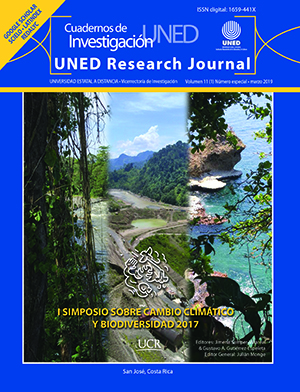Ecosistemas marinos antárticos después del rompimiento de barreras de hielo
DOI:
https://doi.org/10.22458/urj.v11i1.2318Palabras clave:
barreras de hielo, Antártida, ecosistema, fitoplancton, vientos mistralesResumen
Los desprendimientos en las barreras de hielo antárticas proveen una oportunidad única para entender la evolución de ecosistemas costeros y las consecuencias de cambio global abrupto en altas latitudes. Los ecosistemas desarrollados debajo de las barreras de hielo han estado aislados de la atmósfera por miles de años y permanecen en gran medida desconocidos hasta el presente. Una de las regiones más activas al respecto es el este de la Península Antárctica donde varias barreras de hielo han ido desapareciendo en los últimos 100 años, en un gradiente de norte a sur. El evento más reciente fue el desprendimiento de un témpano gigantesco de 5.800 Km2 de la barrera Larsen C, denominado A68, el 12 de julio de 2017. Una vez que la barrera de hielo desaparece, las aguas subyacentes se encuentran expuestas a la atmósfera en condiciones para sostener crecimiento del fitoplancton. El carbono orgánico producido puede a su vez alimentar zooplancton y bentos y mantener una trama trófica marina. De esta manera, áreas previamente no productivas pueden ahora absorber dióxido de carbono y contribuir a la absorción del mismo por aguas oceánicas.Citas
Bertolin, M. L., & Schloss, I. R. (2009).Phytoplankton production after the collapse of the Larse A Ice Shelf, Antarctica. Polar Biology, 32, 1435-1446.
Bruchhausen, P. M., Raymond, J. A., Jacobs, S. S., DeVries, A. L., Thorndike, E. M., & DeWitt, H. H. (1979). Fish, Crustaceans, and the Sea Floor Under the Ross Ice Shelf. Science, 203(4379), 449-451.
Cape, M. R. (2014). Impacts of atmosphere – ice – ocean interactions on phytoplankton along the coastal Antarctic Peninsula (PhD thesis). University of California San Diego, EE.UU.
Cape, M. R., M. Vernet, M. Kahru, G. Spreen (2014). Polynya dynamics drive primary production in the Larsen A and B embayments following ice shelf collapse. Journal of Geophysical Research-Oceans, 119(1), 572–594.
Cape, M. R., Vernet, M., Skvarca, P., Marinsek, S., Scambos, T., & Domack, E. (2015). Foehn winds link climate-driven warming to ice shelf evolution in Antarctica. Journal of Geophysical Research: Atmospheres, 120(21), 11-037. DOI: 10.1002/2015JD023465
Cook, A. J., & Vaughan, D. G. (2010). Overview of areal changes of the ice shelves on the Antarctic Peninsula over the past 50 years. The Cryosphere, 4(1), 77-98.
Domack, E., Duran, D., Leventer, A., Ishman, S., Doane, S., McCallum, S., ... & Prentice, M. (2005). Stability of the Larsen B ice shelf on the Antarctic Peninsula during the Holocene epoch. Nature, 436(7051), 681.
Ferrigno, J. G., Cook, A. J., Mathie, A. M., Williams, R. S. J., Swithinbank, C., Foley, K.,M., Thomson, A. J., & Sievers, J. (2008). Coastal-change and glaciological map of the Larsen Ice Shelf area, Antarctica: 1940-2005. US Geological Survey Geologic Investigations Map Series, Map I-2600-B, with 28p pamphlet, EE. UU.
Gutt, J., Cape, M., Dimmler, W., Fillinger, L., Isla, E., Lieb, V., ... & Pulcher, C. (2013). Shifts in Antarctic megabenthic structure after ice-shelf disintegration in the Larsen area east of the Antarctic Peninsula. Polar Biology, 36(6), 895-906. DOI:10.1007/s00300-013-1315-7.
Lipps, J. H., Ronan, T. E., & DeLaca, T. E. (1979). Life below the Ross ice shelf, Antarctica. Science, 203(4379), 447-449.
Orsi, A. H., Nowlin Jr, W. D., & Whitworth III, T. (1993). On the circulation and stratification of the Weddell Gyre. Deep Sea Research Part I: Oceanographic Research Papers, 40(1), 169-203.
Perovich, D. K. (1990) Theoretical estimates of light reflection and transmission by spatially complex and temporally varying sea ice covers. Journal of Geophysical Research, 95, 9557-9567.
Riddle, M. J., Craven, M., Goldsworthy, P. M., & Carsey, F. (2007). A diverse benthic assemblage 100 Km from open water under the Amery Ice Shelf, Antarctica. Paleoceanography, 22(1), PA1204. DOI:10.1029/2006PA001327
Russell, N. J. (2000) Toward a molecular understanding of cold activity of enzymes from psychrophiles. Extremophiles, 4, 83-90.
Scambos, T., Hulbe, C., & Fahnestock, M. (2003). Climate-induced ice shelf disintegration in the Antarctic Peninsula. Antarctic Peninsula Climate Variability: Historical and Paleoenvironmental Perspectives. Antarctic Research Series, 79, 79-92.
Smith Jr, W. O., Marra, J., Hiscock, M. R., & Barber, R. T. (2000). The seasonal cycle of phytoplankton biomass and primary productivity in the Ross Sea, Antarctica. Deep Sea Research Part II: Topical Studies in Oceanography, 47(15-16), 3119-3140.
Publicado
Cómo citar
Número
Sección
Licencia
Nota: Este resumen contiene un copyright incorrecto debido a problemas técnicos. Los autores que publican en esta revista aceptan los siguientes términos: Los autores conservan los derechos de autor y otorgan a la revista el derecho de primera publicación, con la obra simultáneamente bajo una Licencia de Atribución de Creative Commons que permite a otros compartir la obra con el reconocimiento de la autoría y la publicación inicial en esta revista.
Los contenidos se pueden reproducir citando la fuente según la licencia de Acceso Abierto CC BY 4.0. El almacenamiento automático en repositorios está permitido para todas las versiones. Incentivamos a los autores a publicar los datos originales y bitácoras en repositorios públicos, y a incluir los enlaces en todos los borradores para que los revisores y lectores puedan consultarlos en cualquier momento.
La revista está financiada con fondos públicos a través de la Universidad Estatal a Distancia. La independencia editorial y el cumplimiento ético están garantizados por la Comisión de Editores y Directores de Revistas de la UNED. No publicamos pautas publicitarias pagadas ni recibimos financiamiento de la empresa privada.
